
Dinocephalosaurus is a genus of long necked, aquatic protorosaur that inhabited the Triassic seas of China. The genus contains the type and only known species, D. orientalis, which was named by Chun Li in 2003. Unlike other long-necked protorosaurs, Dinocephalosaurus convergently evolved a long neck not through elongation of individual neck vertebrae, but through the addition of neck vertebrae that each had a moderate length. As indicated by phylogenetic analyses, it belonged in a separate lineage that also included at least its closest relative Pectodens, which was named the Dinocephalosauridae in 2021. Like tanystropheids, however, Dinocephalosaurus probably used its long neck to hunt, utilizing the fang-like teeth of its jaws to ensnare prey; proposals that it employed suction feeding have not been universally accepted. It was probably a marine animal by necessity, as suggested by the poorly-ossified and paddle-like limbs which would have prevented it from going ashore.
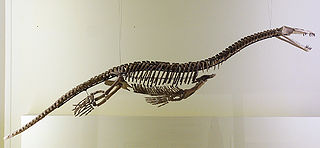
Nothosaurus is an extinct genus of sauropterygian reptile from the Triassic period, approximately 240–210 million years ago, with fossils being distributed from North Africa and Europe to China. It is the best known member of the nothosaur order.

Askeptosaurus is an extinct genus of askeptosauroid, a marine reptile from the extinct order Thalattosauria. Askeptosaurus is known from several well-preserved fossils found in Middle Triassic marine strata in what is now Italy and Switzerland.
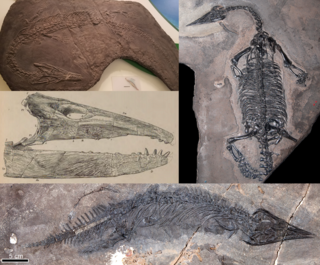
Thalattosauria is an extinct order of prehistoric marine reptiles that lived in the Middle to Late Triassic. Thalattosaurs were diverse in size and shape, and are divided into two superfamilies: Askeptosauroidea and Thalattosauroidea. Askeptosauroids were endemic to the Tethys Ocean, their fossils have been found in Europe and China, and they were likely semiaquatic fish eaters with straight snouts and decent terrestrial abilities. Thalattosauroids were more specialized for aquatic life and most had unusual downturned snouts and crushing dentition. Thalattosauroids lived along the coasts of both Panthalassa and the Tethys Ocean, and were most diverse in China and western North America. The largest species of thalattosaurs grew to over 4 meters (13 feet) in length, including a long, flattened tail utilized in underwater propulsion. Although thalattosaurs bore a superficial resemblance to lizards, their exact relationships are unresolved. They are widely accepted as diapsids, but experts have variously placed them on the reptile family tree among Lepidosauromorpha, Archosauromorpha, ichthyosaurs, and/or other marine reptiles.

Miodentosaurus is a genus of thalattosaurian from the Late Triassic of China. It is one of several thalattosaurs found in the Xiaowa Formation, also known as the Wayao Member of the Falang Formation. The genus name "Miodentosaurus" translates to "Few toothed-lizard" while the species name "brevis" means "short", in reference to its short snout.

Thalattosaurus meaning "sea lizard," from the Attic Greek thalatta (θάλαττα), "sea," and sauros (σαῦρος), "lizard," is an extinct genus of marine reptile in the family Thalattosauroidea. They were aquatic diapsids that are known exclusively from the Triassic period. It was a 2–3 metres (6.6–9.8 ft) long shellfish-eating reptile with paddle-like limbs and a down-turned rostrum occurring in the Lower and Middle Triassic Sulphur Mountain Formation of British Columbia as well as the Upper Triassic Hosselkus Limestone of California. It has gained notoriety as a result of studies on general diapsid phylogeny.
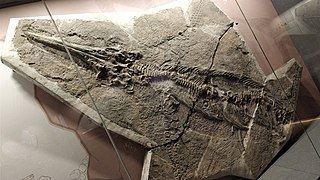
Guizhouichthyosaurus is an extinct genus of ichthyosaur which is known primarily from the Xiaowa Formation of the lower Carnian stage of the Late Triassic in southwest China. The type species of this genus is Guizhouichthyosaurus tangae, of which multiple skeletons are known. It has been reassigned as a species of the genus Shastasaurus in the past, though it has since been considered distinct. The ichthyosaurs Cymbospondylus asiaticus, named in 2002, and Panjiangsaurus epicharis, named in 2003, are junior synonyms of G. tangae. The genus is also known from the Ladinian-aged Middle Triassic Zhuganpo Formation; additionally, the species "Callawayia" wollongangense may belong to Guizhouichthyosaurus.
The Guanling Formation is a Middle Triassic geologic formation in southwestern China.

Sinosaurosphargis is an extinct genus of basal marine saurosphargid reptile known from the Middle Triassic Guanling Formation of Yunnan and Guizhou Provinces, southwestern China. It contains a single species, Sinosaurosphargis yunguiensis.
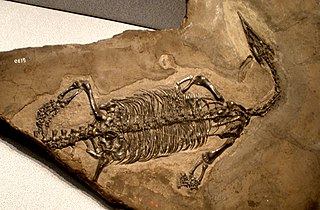
Askeptosauroidea is a superfamily of thalattosaurs, a Triassic group of marine reptiles. Askeptosauroidea is one of two major subgroups of Thalattosauria, the other being Thalattosauroidea. It includes the family Askeptosauridae and a more basal form called Endennasaurus.

Askeptosauridae is a family of thalattosaurs within the superfamily Askeptosauroidea. Fossils have been found from Italy, Switzerland, and China. Askeptosaurids are distinguished from other thalattosaurs by their long necks and narrow skulls.

Thalattosauroidea is a superfamily of thalattosaurs, a Triassic group of marine reptiles. It was named in 1904 by paleontologist John Campbell Merriam to include the genus Thalattosaurus from California. Thalattosauroids are one of two groups of Thalattosauria, the other being Askeptosauroidea. Thalattosauroids make up the "traditional" thalattosaurs with large downturned snouts, short necks, and long, paddle-like tails.
Largocephalosaurus is an extinct genus of basal saurosphargid, a marine reptile known from the Middle Triassic Guanling Formation of Yunnan and Guizhou Provinces, southwestern China. It contains a type species, Largocephalosaurus polycarpon, and a second species L. qianensis.
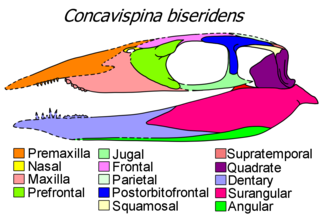
Concavispina is an extinct genus of thalattosaur reptile from the early Late Triassic Xiaowa Formation of Guangling, Guizhou, southern China. It contains a single species, Concavispina biseridens. It is known only from the holotype ZMNH M8804, a nearly complete 364 cm long skeleton. Concavispina can be differentiated from other thalattosaurs by possessing two rows of blunt teeth on the anterior part of the maxilla and a V-shaped notch on the dorsal margin of each neural spine in the dorsal (back) vertebrae. Both its generic and specific names refer to these autapomorphies, as Concavispina means "concave spine" and biseridens means "two rows of teeth". It is thought to be most closely related to Xinpusaurus, as both taxa share three derived characters: a maxilla that is curved upward at its anterior end, a humerus that is wider near the shoulder than near the elbow, and the presence of less than five cervicals.
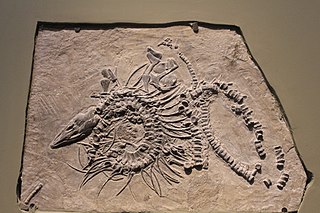
Xinpusaurus is an extinct genus of thalattosaur from the Late Triassic of Guanling in Guizhou, China. Several species have been named since 2000: the type species X. suni along with the species X. bamaolinensis and X. kohi. A 2013 study proposed that all three species are synonymous with each other, in which case X. suni would be the only valid species, although a 2014 study argued that X. kohi was also valid. A fourth species, X. xingyiensis, was described in 2016.

Blezingeria is an extinct genus of marine reptile from the Middle Triassic of Germany. The type and only species Blezingeria ichthyospondyla was named by German paleontologist Eberhard Fraas in 1896. It is known from many isolated bones that come from a deposit in southwestern Germany called the Upper Muschelkalk, which dates back to the Ladinian stage. The relationships of Blezingeria are uncertain. Fraas identified it as a nothosaur, but it has also been classified as a cymbospondylid ichthyosaur, and most recently a thalattosaur. Many thalattosaur fossils have been found in a slightly olderLate Ladinian-age rock unit in Monte San Giorgio, Switzerland, so if Blezingeria is a thalattosaur, it may represent an early stage in an evolutionary radiation of the group across the Tethys, an ocean that covered much of what is now Europe and southern China during the Triassic. However, since Blezingeria is known from very incomplete material, its classification as a thalattosaur remains uncertain.

Pectodens is an extinct genus of archosauromorph reptile which lived during the Middle Triassic in China. The type and only species of the genus is P. zhenyuensis, named by Chun Li and colleagues in 2017. It was a member of the Archosauromorpha, specifically part of the unnatural grouping Protorosauria. However, an unusual combination of traits similar and dissimilar to other protorosaurs initially led to confusion over its evolutionary relationships. In 2021, it was placed in a newly-established group, Dinocephalosauridae, along with its closest relative Dinocephalosaurus.
The Xiaowa Formation is a Carnian-age geological formation found in southern China. It is a sequence of limestone and marls from the Carnian stage of the Triassic. Its lower section was previously known as the Wayao Formation or Wayao Member of the Falang Formation. In 2002, the Wayao Member was renamed and raised to the Xiaowa Formation to prevent confusion with an Eocene unit of the same name. Crinoids and marine reptiles are abundant in the Xiaowa Formation, forming a lagerstätte known as the Guanling biota. Ammonoids and conodonts found in the formation constrain its age to the early Carnian. Reptiles of the Guanling biota include ichthyosaurs, thalattosaurs, placodonts, and Odontochelys. Sedimentary events within this formation have been tied to the Carnian Pluvial Event.
The Zhuganpo Formation is a Triassic geologic unit found in southern China. It has historically been known as the Zhuganpo Member of the Falang Formation. A diverse fossil assemblage known as the Xingyi biota or Xingyi Fauna can be found in the upper part of the Zhuganpo Formation. Fossils of the Xingyi biota include articulated skeletons of marine reptiles, abundant fish, and a plentiful assortment of invertebrates indicating a Ladinian to Carnian age for the sediments of the formation.






















